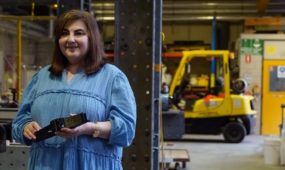Barossa chaff business fuels Asia's racing industry
Innovation
The Nitschke family in South Australia simply couldn’t give a fig about sorting the wheat from the chaff.

Sign up to receive notifications about new stories in this category.
Thank you for subscribing to story notifications.
Because for the past century the chaff has been far more valuable to them.
In that decidedly Germanic tradition of South Australia's Barossa Valley, Frederick Wilhelm Nitschke bought himself a small 100ha block there in 1912.
But with his new Greenock farm came a chaff mill, rather than the de rigueur grapevines, and a family business was born.
Herr Nitschke would be hard put recognising the old operation today, however.
When he started out, his chaff was only good for customers within reach of a horse and dray. And he had men hacking a swathe through the fields with good old Sunshine binders cutting sheaves which were hand stacked into stooks and left for weeks to be sun dried (or longer depending on rain).
Today Nitschke Chaff goes all over the country – and to Asia. And is almost exclusively for the horse racing industry.
A delivery service which has been fast-tracked by the installation of a US-made state-of-the-art robotic packing machine.
Matthew Nitschke, who now runs the family business, says the big advantage of the robotic system is its precise plastic-wrap baling – 585mm x 390mm and 345mm high.
But the new technology was not without its teething problems. The plastic wrap caused a lot of sweating issues.
“Particularly when we might have been wrapping on a 12C day in SA and then delivering to Darwin and 90 per cent humidity or Malaysia, Singapore and Macau where we had the same problem,” he says.
“We solved it by perforating the wrap to create breathing holes.
“The big advantage of the new system is the consistency which increased the volume we could deliver by truck or shipping container.
“Much better than the old nylon bag system although some of our more traditional customers still ask for those.”
But when your own fleet of trucks is heading to places as far flung as Cairns, Darwin and the Atherton Tableland every other week, every cubic centimetre of space counts.
Particularly when your customers include the likes of John Singleton and the Magic Millions in Brisbane.
“With the new system I get 42 cubes to the pallet, and at 40 pallets to the tonne we should get 22 tonnes on the truck,” Matthew says.
“This kind of production will also let us go after new markets because we will be able to work more successfully with commercial transporters if we can guarantee and size and weight for every trip,” he says.
“We sell to every mainland state except WA – nothing gets in there although they are happy to sell to the rest of the country.
“Our chaff also goes to Asia and we are targeting more markets there with big horse racing industries, such as Hong Kong.”
The South Australian chaff industry has had to be innovative and mobile because Matthew says local demand has been steadily drying up in tandem with falling numbers of race meetings.
The formula to his in-demand chaff is still a family secret.
“I can't say too much, it is a bit like Colonel Sanders and his secret herbs and spices,” Nitschke says. “But if you keep the stalk straight going into the cutter you produce a more consistent size.”
Moisture is maintained at around 14-16 per cent after being super steamed at 200C which Nitschke says “toughens it up” so stalks are not brittle and don't smash in the cutter.
Although the robotic machine cut out two jobs, but those employees couldn't wait for the day. His mother and father, he says, had had enough and were more than happy to be replaced by a robot – or anyone else who wanted to take on the role.
“Mum's 68 and Dad's 73 now, and he has been working in the business most of his life,” Nitschke says.
“But they needn't think they are getting right out of it, I am sure I will still need them from time to time,” he says. “To find parts or run fuel around. There is always something to be done and never enough people to do it.”
Jump to next article



